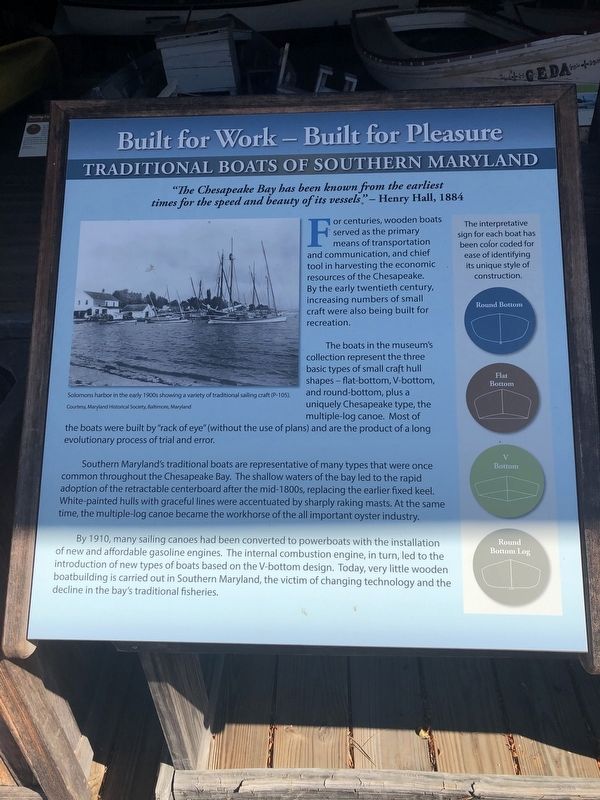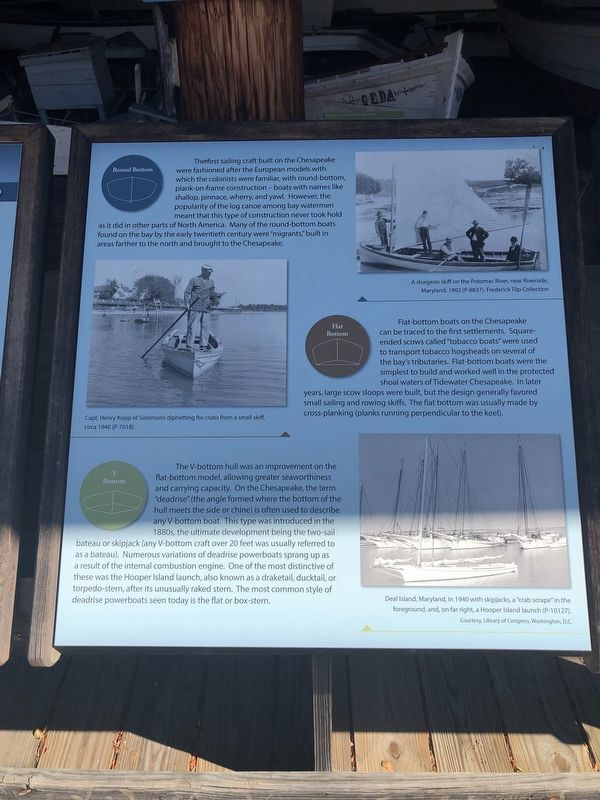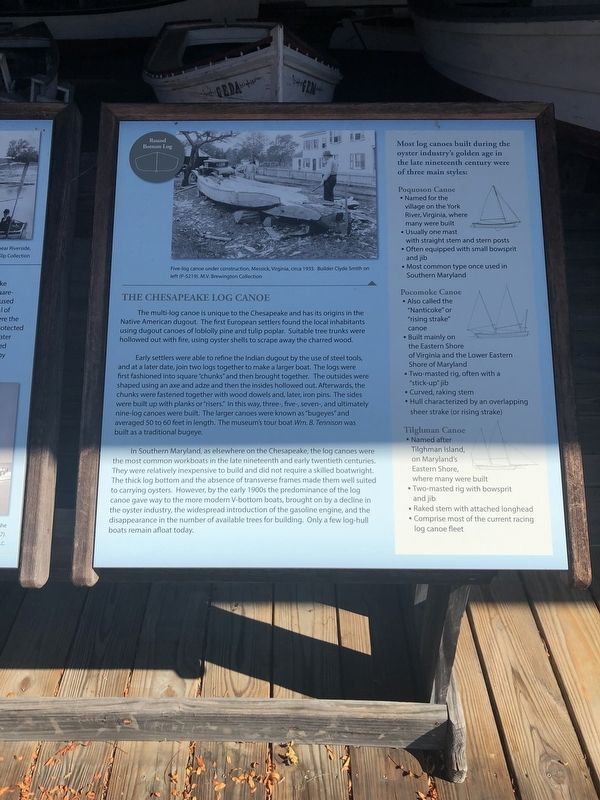Solomons in Calvert County, Maryland — The American Northeast (Mid-Atlantic)
Built for Work Built for Pleasure
Traditional Boats of Southern Maryland

Photographed By Devry Becker Jones (CC0), August 30, 2019
1. Built for Work — Built for Pleasure Marker
For centuries, wooden boats served as the primary means of transportation and communication, and chief tool in harvesting the economic tool in harvesting the economic resource of the Chesapeake. By the early twentieth century, increasing numbers of small craft were also being built for recreation.
The boats in the museum's collection represent the three basic types of small craft hull shapes — flat-bottom, V-bottom, and round-bottom, plus a uniquely Chesapeake type, the multiple-log canoe. Most of the boats were built by "rack of eye" (without the use of plans) and are the product of a long evolutionary process of trial and error.
Southern Maryland's traditional boats are representative of many types that were once common throughout the Chesapeake Bay. The shallow waters of the bay led to the rapid adoption of the retractable centerboard after the mid-1800s, replacing the earlier fixed keel. White-painted hulls with graceful lines were accentuated by sharply raking masts. At the time, the multiple-log canoe became the workhorse of the all important oyster industry.
By 1910, many sailing canoes had been converted to powerboats with the installation of new and affordable gasoline engines. The internal combustion engine, in turn, led to the introduction of new types of boats based on the V-bottom design. Today, very little wooden boatbuilding is carried out in Southern Maryland, the victim of changing technology and the decline in the bay's traditional fisheries.
Round Bottom
The first sailing craft built on the Chesapeake were fashioned after the European models with which the colonists were familiar, with round-bottom, plank-on-frame construction — boats with names like shallop, pinnace, wherry, and yawl. However, the popularity of the log canoe among bay watermen meant that this type of construction never took hold as it did in other parts of North America. Many of the round-bottom boats found on the bay by the early twentieth century were "migrants," built in areas farther to the north and brought to the Chesapeake.
Flat Bottom
Flat-bottom boats on the Chesapeake can be traced to the first settlements. Square-ended scows called "tobacco boats" were used to transport tobacco hogsheads on several of the bay's tributaries. Flat-bottom boats were the simplest to build and worked well in the protected shoal waters of Tidewater Chesapeake. In later years, large scow sloops were built, but the design generally favored small sailing and rowing skiffs. The flat bottom was usually

Photographed By Devry Becker Jones (CC0), August 30, 2019
2. Built for Work — Built for Pleasure Marker
V Bottom
The V-bottom hull was an improvement on the flat-bottom model, allowing greater seaworthiness and carrying capacity. On the Chesapeake, the term "deadrise" (the angle formed where the bottom of the hull meets the side or chine) is often used to describe any V-bottom boat. This type was introduced in the 1880s, the ultimate development being the two-sail bateau or skipjack (any V-bottom craft over 20 feet was usually referred to as a bateau). Numerous variations of deadrise powerboats sprang up as a result of the internal combustion engine. One of the most distinctive of these was the Hooper Island launch, also known as a draketail, ducktail, or torpedo-stern, after its unusually raked stern. The most common style of deadrise powerboats seen today is the flat or box-stern.
Round Bottom Log
The Chesapeake Log Canoe
The multi-log canoe is unique to the Chesapeake and has its origins in the Native American dugout. The first European settlers found the local inhabitants using dugout canoes of loblolly pine and tulip popular. Suitable tree trunks were hollowed out with fire, using oyster shells to scrape away the charred wood.
Early settlers were able to refine the Indian dugout by the use of steel tools, and a later date, join two logs together

Photographed By Devry Becker Jones (CC0), August 30, 2019
3. Built for Work — Built for Pleasure Marker
In Southern Maryland, as elsewhere on the Chesapeake, the log canoes were the most common workboats in the late nineteenth and early twentieth centuries. They were relatively inexpensive to build and did not require a skilled boatwright. The thick log bottom and the absence of transverse frames made them well suited to carrying oysters. However, by the early 1900s the predominance of the log canoe gave way to the more modern V-bottom boats, brought on by a decline in the oyster industry, the widespread introduction of the gasoline engine, and the disappearance in the number of available trees for building. Only a few log-hull boats remain afloat today.
[Aside:]
Most log canoes built during the oyster industry's golden age in the late nineteenth century were of three main styles:
Poquoson Canoe
Named for the village on the York River, Virginia,

Photographed By Devry Becker Jones (CC0), August 30, 2019
4. Built for Work — Built for Pleasure Marker
Usually one mast with straight stem with stern posts
Often equipped with small bowsprit and jib
Most common type once used in Southern Maryland
Pocomoke Canoe
Also called the "Nanticoke" or "rising strake" canoe
Built mainly on the Eastern Shore of Virginia and the Lower Eastern Shore of Maryland
Two-masted rig, often with a "stick-up" jib
Curved, raking stern
Hull characterized by an overlapping sheer strake (or rising strake)
Tilghman Canoe
Named after Tilghman Island, on Maryland's Eastern Shore, where many were built
Two-masted rig with bowsprit and jib
Raked stem with attached longhead
Comprise most of the current racing log canoe fleet
Erected by Calvert Marine Museum.
Topics. This historical marker is listed in these topic lists: Animals • Industry & Commerce • Waterways & Vessels. A significant historical year for this entry is 1884.
Location. 38° 19.882′ N, 76° 27.841′ W. Marker is in Solomons, Maryland, in Calvert County. Marker can be reached from Solomons Island Road South (Maryland Route 2) just south of Thomas Johnson Road, on the left when traveling south. Touch for map. Marker is at or near this postal address: 14150 Solomons Island Road South, Solomons MD 20688, United States of America. Touch for directions.
Other nearby markers. At least 8 other markers are within walking distance of this marker. Humphreys Rowing Skiff (here, next to this marker); Benning Crab Skiff (here, next to this marker); Jolly Boat (here, next to this marker); Jenkins Creek Crab Scrape Geda (here, next to this marker); Oyster Skiff (a few steps from this marker); Sewell Draketail Workboat (a few steps from this marker); Whittington Rail Skiff (a few steps from this marker); Crab Skiff Pep (Reproduction) (a few steps from this marker). Touch for a list and map of all markers in Solomons.
Credits. This page was last revised on August 30, 2019. It was originally submitted on August 30, 2019, by Devry Becker Jones of Washington, District of Columbia. This page has been viewed 173 times since then and 17 times this year. Photos: 1, 2, 3, 4. submitted on August 30, 2019, by Devry Becker Jones of Washington, District of Columbia.